Maya Turner’s historic run as Bisons football kicker continues
Even before the Canadian news media descended on Bisons football kicker Maya Turner after she made history and secured the much-needed first win of the football season on Sept. 23, Turner was already in the record books

In August 2022, Turner became the first woman to make points in a U Sports football game, kicking a 25-yard field goal against the University of Saskatchewan Huskies in the Bisons pre-season game.

The historic points were a long time coming in U Sports history but also for Turner herself, having gotten her start in soccer.
“I’ve always loved football,” she said. “I always thought it would be really fun to play and try to kick field goals, but I never thought that that would be something I would be able to do because I was so busy with soccer, and because girls don’t usually play football.”
After quitting varsity soccer, the Maple Grove, Minn. product tried out for the kicking position on the Loyola University Chicago Ramblers football club team. Reaching out to schools in both the United States and Canada, she finally found her football home after a visit to the University of Manitoba.
“I just really loved the environment here, and all the staff and all the people I met,” Turner explained.
“I just knew that this was the place for me after I went on my visit here.”
The rest is literally history.
Building off her work from last pre-season, Turner made two field goals for the Bisons
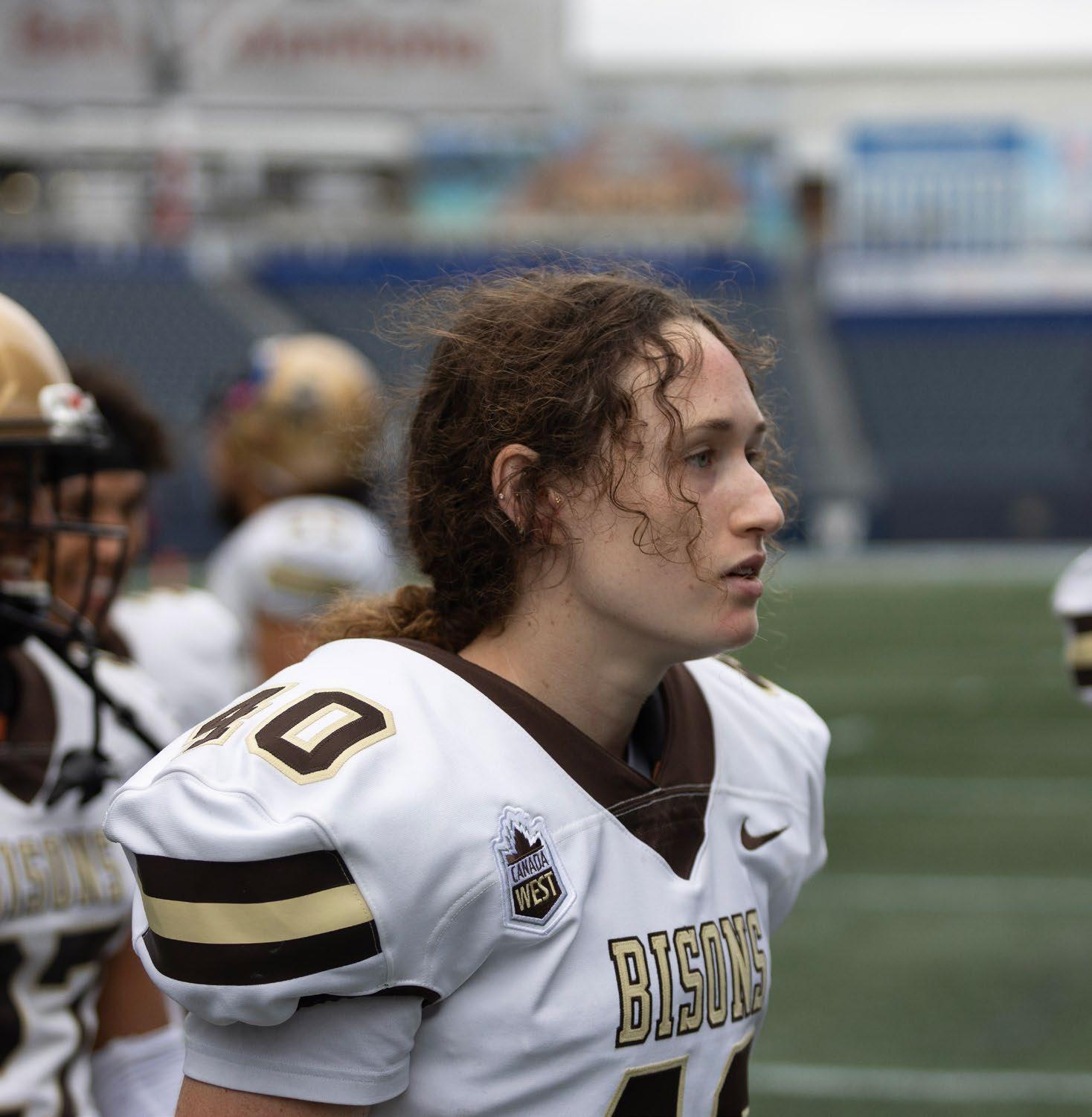
in the 2023 pre-season contest against the University of Regina Rams — a 39-yarder and a 15-yarder. But her 2023 season wouldn’t stop there.
Turner made history again on Sept. 23 when she became not only the first woman to dress for a regular season U Sports football game but also the first woman to make points in a regular season U Sports football game.
Kicking her way into the record books, Turner put up nine points during the regular season game against the Rams at IG Field. She opened the scoring for Manitoba with a 21-yard field goal in the second quarter, followed by three one-point conversions before kicking the game-winning field goal in second overtime.
The recipe for Turner’s success is her game-time objective of staying “focused and in the moment” while on the gridiron. While her training
in staying focused has worked every time she has taken the field with the Bisons, Turner did admit it was nerve-wracking leading up to that fateful September Saturday with the attention her presence on the gridiron had garnered.
“I knew that if I were to make a mistake, that would also be magnified,” Turner said.
“When it came down to it, I was just really excited to go on the field and get my chance.”
Turner’s teammates and coaches were thrilled for her success and have “always been really welcoming and supportive.”
“They respect me for the player I am,” Turner said.
Even more respect poured in from the Canadian Football League (CFL), who contacted Bison head coach Brian Dobie asking if the league can put an item of Turner’s from the historic game in the Canadian Football Hall of Fame.
“I just felt so honoured that the CFL would reach out and ask me for that,” Turner said. “After this season, I might give them my cleats.”
Turner will continue to make history this season in the Bisons, Canada West and U Sports record books as she takes over kicking duties for the herd.
On Sunday, she recorded 10 points against the University of Calgary Dinos in the Bisons fourth consecutive regular season win against the team.
As for her future with the herd, Turner is still in her first year of eligibility, and knows there’s still a lot of football left to play.
“I just want to improve as much as I can while I’m here,” Turner said.
“I want to play football for as long as I can.”
sports@themanitoban.com
EDITOR-IN-CHIEF Gillian Brown editor@themanitoban.com
BUSINESS MANAGER Dhruv Patel accounts@themanitoban.com
ADVERTISING CO-ORDINATOR Diego Castro ads@themanitoban.com
EDITORIAL
MANAGING EDITOR Ezra Taves me@themanitoban.com
COPY EDITOR Simon Pensato copy@themanitoban.com
NEWS EDITOR Sarah Cohen news@themanitoban.com
NEWS EDITOR Kyra Campbell news@themanitoban.com
RESEARCH & TECHNOLOGY EDITOR Elah Ajene research@themanitoban.com
COMMENT EDITOR Jessie Krahn comment@themanitoban.com

ARTS & CULTURE EDITOR Jacob Davis arts@themanitoban.com
SPORTS EDITOR Grace Anne Paizen sports@themanitoban.com
DESIGN
DESIGN EDITOR Taeran An design@themanitoban.com
GRAPHICS EDITOR Teegan Gillich graphics@themanitoban.com

AUDIO AND VIDEO
AUDIO EDITOR Harmatpreet Brar audio@themanitoban.com
PHOTO EDITOR Ebunoluwa Akinbo photo@themanitoban.com
VIDEO EDITOR Kennedy Legault video@themanitoban.com
SOCIAL MEDIA EDITOR Violet Baker social@themanitoban.com
REPORTERS
109 HELEN GLASS BUILDING
UNIVERSITY OF MANITOBA
WINNIPEG, MB
204. 474. 6535
Correction, “New OCD support group to begin operating in Winnipeg”: The article originally used incorrect terminology regarding the structure of Winnipeg OCD. The group was previously reported to be a “treatment” but is a peer support program. Additionally, the program does not have staff. Walter runs the group as a volunteer.

The Manitoban is the official student newspaper of the University of Manitoba. It is published monthly during the summer and each week of regular classes during the academic year by the Manitoban Newspaper Publications Corporation.

The Manitoban is an independent and democratic student organization, open to participation from all students. It exists to serve its readers as students and citizens.

The Manitoban is a member of the Canadian University Press, and our journalistic standards can be found on the Manitoban’s website.

The newspaper’s primary mandate is to report fairly and objectively on issues and events of importance and interest to the students of the University of Manitoba, to provide an open forum for the free expression and exchange of opinions and ideas and to stimulate meaningful debate on issues that affect or would otherwise be of interest to the student body and/ or society in general. The Manitoban serves as a training ground for students interested in any aspect of journalism.
Students and other interested parties are invited to contribute to any section of the newspaper. Please contact the appropriate editor for submission guidelines.
The Manitoban reserves the right to edit all submissions and will not publish any material deemed by its Editorial Board to be discriminatory, racist, sexist, homophobic or transphobic, ableist or libellous.

Opinions expressed in letters and articles are solely those of the authors. Editorials in the Manitoban are signed and represent the opinions of the writer(s), not necessarily those of the Manitoban staff, Editorial Board or the publisher.
A “volunteer staff” member is defined as a person who has had three volunteer articles, photographs or pieces of art of reasonable length and/ or substance published in the current publishing year of the Manitoban.
VOLUNTEERS

VOLUNTEER STAFF
Bahareh Rashidi, Matthew Merkel
VOLUNTEER Christina Tran, Sky Downing interested in volunteering?
email me@themanitoban.com today!
Any individual who qualifies as a volunteer staff member must be voted in by a majority vote at a Manitoban editorial board meeting. Elected representatives and non-students may be excluded from holding votes as volunteer staff members in accordance with the Manitoban Constitution.
All contents are ©2023 and may not be reprinted without the express written permission of the Editor-in-Chief.
3 to 4
5 to 6
8 to 12
13
14 to 16
18 to 20
Provincial party candidates speak on racial issues
Student group hosts panel for party representatives on racialized issues
Sarah cohen, staff
Racial issues are widely important for student voters this election season.
To inform the student body, one group invited provincial candidates to talk about their stances.
Allisther De Castro and Ivan Nunez-Gamez are co-presidents of the Racial Equity and Inclusion Alliance (REIA), a student-run organization on campus with the goal of amplifying the voices of BIPOC students.
Nunez-Gamez emphasized the importance of political engagement among students.
“Civic engagement is crucial,” he said.
“As Winnipeg is a multi-cultural hub, and so is the University of Manitoba, we found ourselves [with] the duty of displaying what each party had to offer to the racialized community.”
Nunez-Gamez, De Castro and the rest of REIA gave notice to the Manitoba Liberal Party, Manitoba Green Party, Manitoba New Democratic Party (NDP) and Manitoba Progressive Conservative (PC) Party. The group also reached out to the Communist Party and the Keystones and did not receive a response. The PCs declined to send a representative via email three hours prior to the event beginning.
Iqra Tariq, Liberal MLA candidate for Union Station, Bernadette Smith, NDP MLA
candidate for Point Douglas and Janine Gibson, leader of the Green party and MLA candidate for Wolseley made up the panel.
The panel was divided into three sections: systemic barriers, achieving racial equity in post-secondary education and reconciliAction. De Castro said the third portion, named reconciliAction, was used to allow candidates to highlight their parties’ commitment to policies that take action to move reconciliation forward.
Systemic barriers
When asked about systemic factors contributing to racialized poverty rates in Winnipeg, NDP candidate Smith said that the NDP would institute scholarships and bursaries for those who need funding to access education.
Tariq’s response covered the Liberal party’s platform on homelessness and income support, while also addressing addiction support. She said it is important to “become aware of the risk factors that put people into poverty, and have interventions in place to prevent these things before they become actual crises.”
Gibson said that the Green party would have a “basic income guarantee” to help address the issues of poverty in Winnipeg. She spoke on her personal experience with the
“mincome” program, part of an experimental guaranteed income.
Gibson said our province should be a “friendly Manitoba for all, and not just for the privileged.”
Racial equity in post-secondary education
Candidates were asked whether or not each party would support a policy mandating the collection of data on religion, race, Indigenous identities and ethnic origins of students.
Gibson said she would institute this policy because of the lack of respect rooted in colonialism that many individuals are facing.
“We are all human beings with human rights that deserve to be treated equal under the law,” she said.
Gibson emphasized the need for “transparency and accountability” in a government that regulates individuals’ identities with the goal of tracking those who are missing.
Smith talked about the lack of Indigenous representation within universities and highlighted the need to focus on eradicating the systemic barriers that block Indigenous people and people of colour from accessing the education system.
She said that the govern-
ment needs to change things from “the inside out.”
Tariq shared her experiences as a person of colour and religious minority running for office. Her signs have been vandalized and she has received the message that some constituents “don’t want this kind of representation.”
She said the Liberal party, if they form a majority government, will offer funding to universities and colleges and reinstate health care for international students who are giving “tens of thousands if not millions of dollars” to the Manitoba economy as students or after they graduate.
ReconciliAction
In the final section, participants were asked if they support a search of the Prairie Green Landfill.
It is thought that the remains of missing Indigenous women are located at the Prairie Green Landfill. Despite many calls to search the landfill, Manitoba Premier Heather Stefanson said she will not support a search.
In response to the question, Tariq said, “This is human life we’re talking about, and we need to return to our basic morals and values to just respect the integrity of people.”
She emphasized that justice needs to be served and that the families of the missing
women need to get answers, and additionally, that preventative measures need to be taken so this does not happen again.
The Green party believes that, while the landfill should be searched, there shouldn’t be landfills in the first place. Gibson said that the Green party supports life cycle legislation. Those who create products are responsible for disposing them. She said that searching the landfill would be “a major step towards reconciliation,” honouring life and a chance to address the harm done to Turtle Island by having landfills at all.
Smith agreed with the importance of searching the landfill. Smith has a sister that has been missing for 15 years. She and her family have been searching for her sister every year and for all they know, she could be in the landfill, she said.
“These are humans, and they don’t deserve to be left there like they’re garbage, they’re not disposable,” she said.
“They are sacred beings, and we need to treat them as such, and they deserve to be looked for like any other person would.” news@themanitoban.com
mural Artist, community work together to bring art to space
Black Students Community to unveil
Sarah cohen, staff
Cole Cancilla considers himself the “visual translator” for the Black Students Community, which chose him to paint a mural in its community space.
Cancilla, a student in the school of art, said the group approached him in early September while working on renovations and asked if he could design and complete the mural within its short time frame, and after agreeing, he began his work.
The mural features mountains Cancilla based on those from Rwanda, and an image of the Nile River sits below the Black Students Community logo. An orange sun is set in front of a “striking yellow” sky, representing a new day.
A splash of water lifts up the logo of the Black Students Community, which Cancilla said represents the ripple effect of its legacy.
“It’s simplistic but it is also bold on its own,” he said.
The logo, designed by Dola Akintan, vice-president student engagement for the Black Students Community, depicts “two hands holding each other,” which represents the community’s strength when it comes together.
Akintan said the main idea behind the mural was to create something that “generations upon generations” of Black students at the U of M could contribute to.
The Black Students Community was built to create a safe space for Black students
across campus to find a home away from home, Akintan said. The entire renovation process for the group’s space took more than a month, but Cancilla got the job done.
“We are so thankful for Cole for doing this on short notice,” said Akintan,
“It was just so wonderful to see him just bring this to life.”
This mural is the student group’s way of starting fresh and turning the representation of its community into a physical display that everyone can look at.
Having a new community space has led to a “significant moment” for the community group, Akintan said. With this new mural, anyone can see, it’s “a new dawn, a new day for us,” she said.
The Black Students Community can be found in 187 Helen Glass and can be reached via Instagram @ blackstudentsuofm or by the news@themanitoban.com
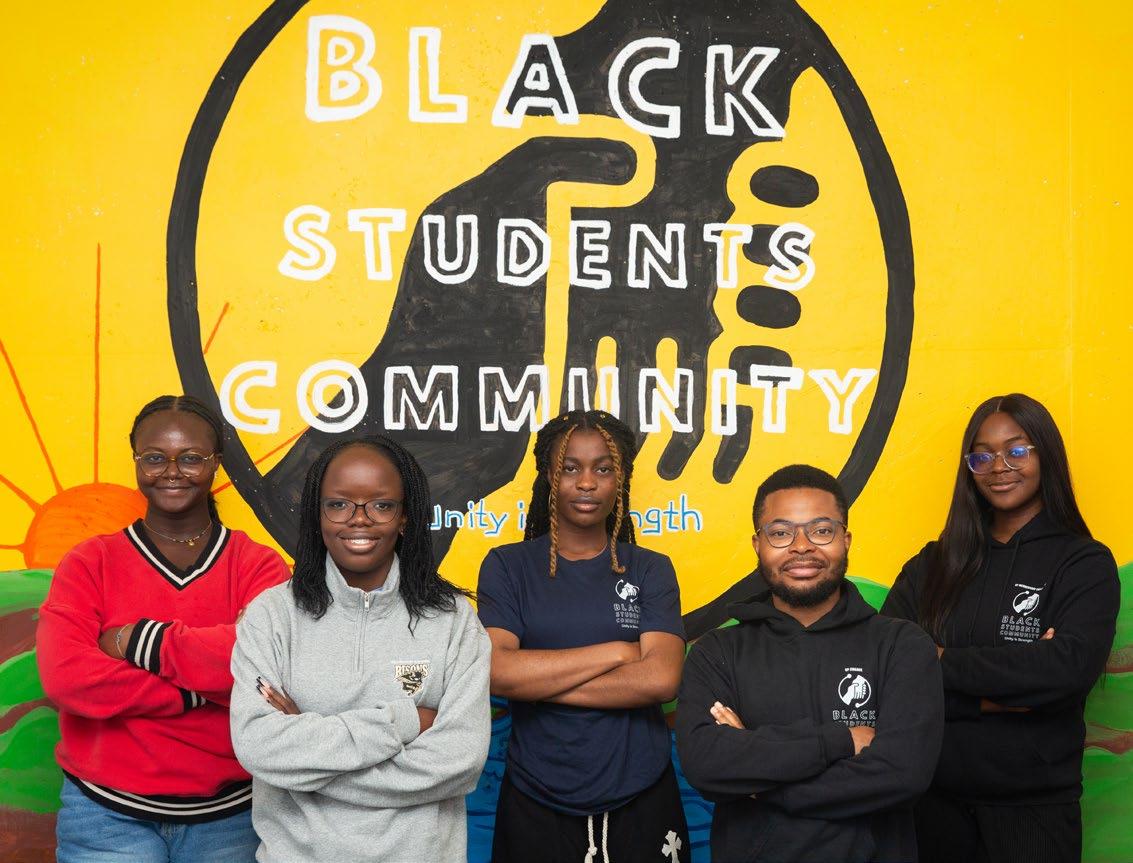
Say cheese!
Learn the ins and outs of dairy with Dairy Club
Sarah cohen staffIce cream, cheese and yogurts—a lactose lover’s paradise exists right here on the U of M campus.

When Jaspal Singh learned that one of his professors was interested in re-starting the U of Manitoba Dairy Club, he was in.
Now, Singh, in his last year of a human nutritional science degree, is president of the U of M Dairy Club.
Singh joined the club because of his love for all things dairy. He knew it was the perfect way to gain experience with the products, learning a lot at the same time.
For Singh, Dairy Club is “a good way to connect the people who are interested in the common role [of dairy],” whether it be the production aspect, or just interest in a certain dairy product.
The club has access to the university’s dairy science building to make products, which has equipment that’s smaller than commercial-sized machines but bigger than the tools one might have at home. An ice cream shop like Bridge Drive In might use a machine of a simi-

lar size, said Singh.
Anyone from any faculty, even graduate students and alumni, can become a member of Dairy Club. As a member, you can learn exactly how to use those machines to make your favourite dairy products.
Even if you are lactose intolerant, Dairy Club still has a place for you. The group sells dairyfree oat milk ice cream as well as regular, and is planning on pursuing some “unique projects” later in the year, like oat milk cheese and oat milk yogurt, Singh said.
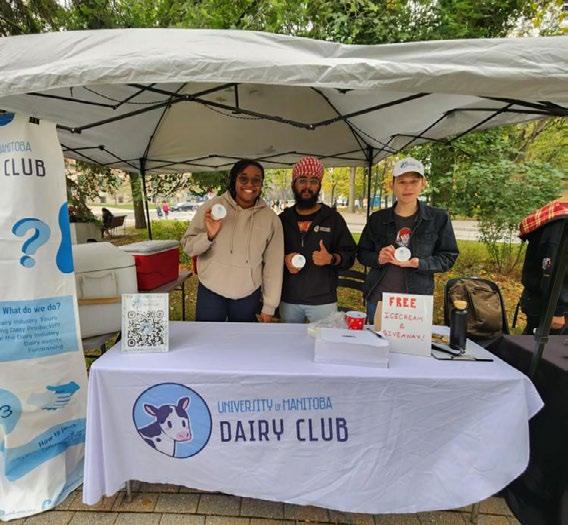
This year, members will be able help with product development, mixing the ingredients, packaging the product and selling it to customers as part of the club’s events. If you don’t want to become a member, you can still taste the club’s various products at any of its sales throughout the year.
To become a member, visit the U of Manitoba Dairy Club Instagram page @uofm_dairy_ club. In its bio, you’ll find a Linktree that will take you straight to the sign-up form.
Candidates make final pitch at student-hosted debate
Provincial leader town hall pressures candidates on tuition, housing and health care
Kyra campbell, staff
Candidates from Manitoba’s four main political parties squared off on Sept. 27 in a town hall debate hosted by UMSU and the university’s political studies student association.
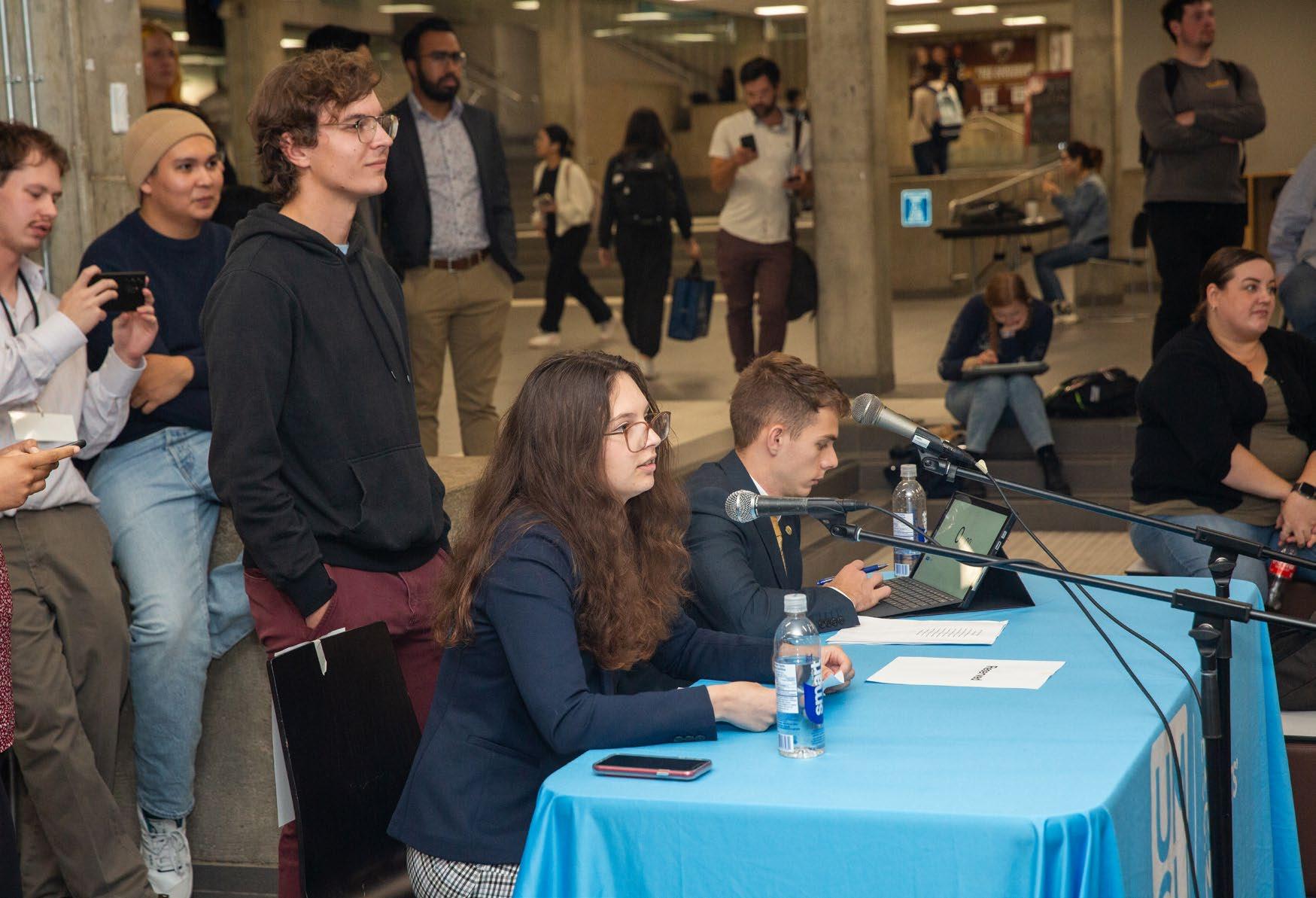
The union, alongside the University of Manitoba Undergraduate Political Studies Students’ Association (UPSSA), called the candidates together to share their parties’ election promises on issues that matter most to students, including housing, tuition and health care.
Manitoba Liberal Party leader Dougald Lamont and Janine Gibson, Manitoba Green Party leader, were the only two provincial party leaders to attend the event, which was titled “Provincial Leaders Townhall.”
One issue on the top of many students’ minds is international student health care — a program cut in 2018 by the Progressive Conservative (PC) government.
When the candidates were asked about international student health care, Progressive Conservative candidate for Midland Lauren Stone said that it was an issue she was “[not] very well versed on.”
The other three parties committed to restoring international student healthcare coverage. Gibson called the removal “shameful” and emphasized the “investment” that providing international student healthcare would be for the province.
“International students give so much to the university and to our culture in Manitoba,” she said.
Jamie Moses, NDP candidate for St. Vital, said reinstating the program would help alleviate the affordability crisis that international students are facing. He wants to see these students choose Manitoba not only for their education, but also to live and work in after graduation.
Lamont said that when it comes to supporting international students, “it’s our responsibility to work for you as a government whether you’re Canadian or not.”
“If you’re here, you’re a Manitoban,” he said.
Tuition has been raised 10.2 percentage points in total over the past three years alone. At the debate, each candidate shared their party’s plans to address it.
Both Lamont and Moses committed to proper funding for universities, including the U of M, so that they would not feel the need to greatly increase tuition prices.
Stone said the PCs are “committed to maintaining [their] status as the most affordable tuition rates in western Canada.” In recent years, provincial legislation has required that Manitoba post-secondary institutions maintain the lowest average tuition across western Canada.
She went on to say that her party recognizes the value of grants compared to repayable student loans, and that the
government has made strong investments in them. The current provincial government has allocated $10 million annually to schools across the province under the Manitoba Scholarship and Bursary Initiative.
Gibson agreed that investing in universities is important, and also addressed the income disparity between university administration and teaching assistants and professors.
Currently, students in Manitoba are struggling to find housing. One topic on many young voters’ minds is how these provincial parties
will address it.
Moses said that if elected, the NDP is willing to work co-operatively with the federal government to solve the housing crisis — a relationship that has been strained under the PC government — as well as with the municipal government.
Stone mentioned that rental rates were frozen for two years under the PC government. Rather than addressing what the PCs will do about the crisis for students, she took time to discuss opportunities for firsttime home buyers.
The Liberals and Greens agreed that creating 10,000
new units of affordable housing is necessary, which Lamont committed to implement if elected. Gibson committed to funding environmentally-friendly jobs required to build that housing.
Manitobans, students and non-students alike, voted for their new provincial government on Oct. 3.
news@themanitoban.com
Research & Technology
Macro-innovation at a micro-scale
New project aims to mitigate greenhouse gas emissions using microbes
elah Ajene, staff
Ivan Oresnik, U of M professor in the department of microbiology, stepped into a lab for the first time in 1985. Over nearly four decades, his work has predominantly been academic.
“I’ve spent a lot of my life trying to figure out how things work at a molecular level,” he said.
However, in the past decade, he has transitioned toward applied research — his motivation shifting toward a broader perspective.
When flying over rivers meeting bodies of water, one can see the discolouration indicative of nutrient runoff from farm land, which can cause environmental issues including dead zones — regions characterized by minimal oxygen levels, where hardly any life thrives below the surface waters — in places like the Gulf of Mexico. This environmental problem left Oresnik thinking about how he could help with the issue and contribute to sustainability.
Since an increase in food yields and spread of novel agricultural technologies known as the green revolu-
tion, commercial agriculture has heavily relied on the application of chemical fertilizers as a primary method of providing nutrients to plants. However, these fertilizers are also responsible for various environmental issues, including up to 2.1 per cent of greenhouse gas emissions worldwide.
To address this, a new $6 million research project, co-lead by Oresnik and Queen’s University biology professor George diCenzo, aims to mitigate greenhouse gas emissions through the use of sustainable microbial alternatives to chemical fertilizers.
“What we’re looking for is a way to reduce the nitrogen input or other fertilizer inputs, but maintaining the same yield that people are used to at this point in time,” Oresnik said.
To achieve this, the team is focused on identifying and isolating microorganisms from Manitoba and Ontario, analyzing their genomic potential and testing their
effects on plants.
The team is primarily examing two areas — one involving barley, wheat and canola, and another concerned with dry beans, which are primarily grown for human consumption.
In the case of dry beans, the common practice in Canada has been to fertilize them with nitrogen due to the lack of a reliable inoculant — a form of bacteria or fungus applied to the soil by coating the seed before planting. Oresnik’s approach involves isolating and screening inoculants to select the microbes that best fertilize dry beans. Being able to use these microbes as a sustainable alternative could decrease or remove the need for nitrogen fertilizer application in dry beans production.
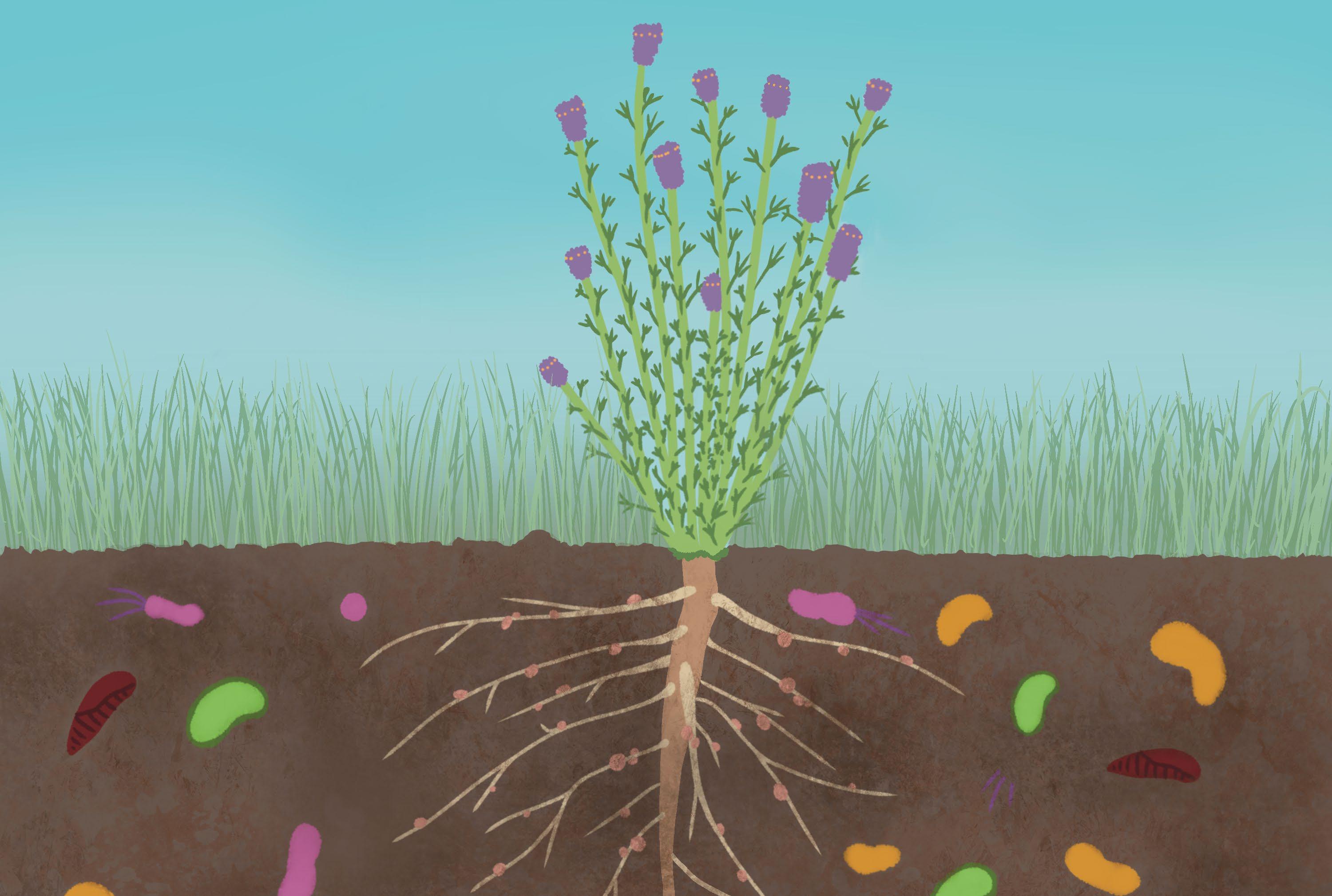
The project further explores microbes that promote plant growth either by supplying nitrogen or increasing the availability of phosphorus, and is examining how to
industrialize the production of these beneficial microbes to ensure their effectiveness in the field.
While microbial products hold promise, they require further refinement. Microbes can enhance plant resilience and nutrient uptake under controlled conditions, but deploying them in the field has been challenging due to their unpredictability in practice and a lack of regulations surrounding them.
“It has eroded a lot of farmer’s trust in these,” Oresnik said.
“Everybody is interested in them, but most people will look at this and say, ‘this is very high risk — looks good, but the track record for these at this point in time is not very good.’”
Aside from microbial isolation, dry beans production and ensuring microbes survive in the field, the project also examines plant reactions and potential molecular traits that can improve interactions between plants and beneficial microbes. The research also delves into social science,
modelling the effects of inoculum usage on greenhouse gas emissions and attempting to understand the factors that affect farmers’ willingness to adopt the process.
Oresnik emphasized the collaborative effort of the project, which has received significant input from grower groups such as the Manitoba Crop Alliance and Manitoba Pulse and Soybean Growers. Many stakeholders recognize the potential of this technology, but some remain skeptical about its scalability and effectiveness on an industrial level.
What sets the project apart, Oresnik explained, is its commitment to address these concerns and provide practical solutions.
Oresnik believes that this initiative could leave a lasting legacy, benefitting not only the current generation but future ones as well.
“If we do this, and it really comes to fruition, it does have the potential for making Manitoba a leader,” he said. “We can leave behind a legacy.”
research@themanitoban.com
“We can leave behind a legacy”
— Ivan Oresnik, U of M professor in the department of microbiology
New project seeks to enhance family well-being
Aims to provide mental health supports and resources for families
elah Ajene, staff
Leslie Roos’s research is rooted in the observation of how mental health challenges affect individuals, and in recognizing opportunities to create a positive impact on people’s lives.
“One of the things that I think was most impactful early on was noticing that, when your mental health isn’t where you want it to be or when you’re struggling with mental health, everything else is really hard,” she said.
Roos is an assistant professor in the department of psychology and a research scientist at the Children’s Hospital Research Institute of Manitoba
Her new project, “Advancing Family Wellbeing through a Massive Open Online Intervention: The LightBEAM,” received funding from the Social Sciences and Humanities Research Council in late August.
This project revolves around empowering families in caring for their mental health.
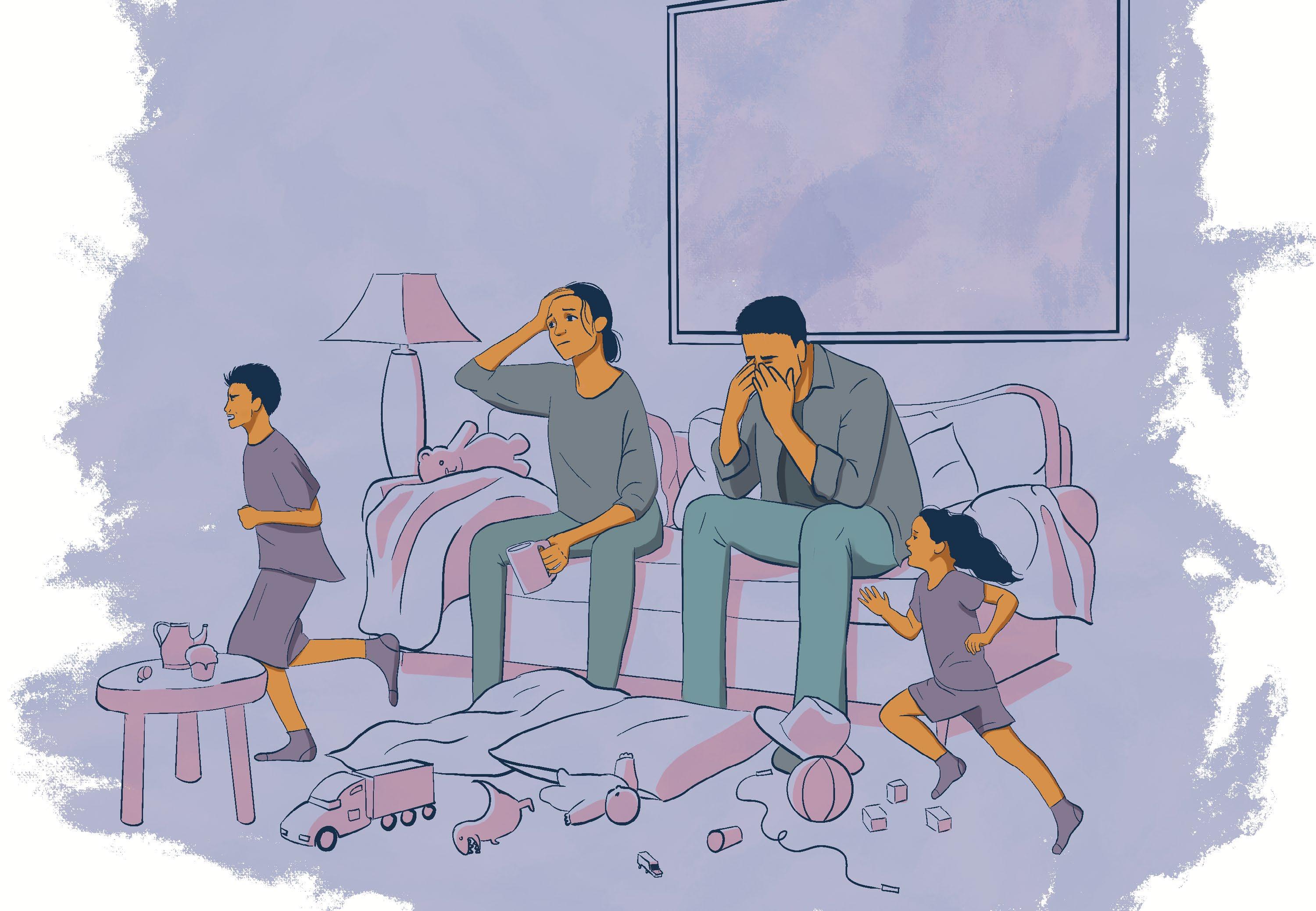
“There’s a lot of really natural things that come up about being a parent that can be tre-
mendously stressful,” Ross said, adding that these things “require a lot of skills and reflection on understanding your own emotional experiences, and how to cope with them and move forward in a way that’s aligned with your values so that you can be living the life you want to live as a parent.”
Recognizing that parenthood comes with a unique set of challenges and joys, Roos aims to provide evidence-based information to assist parents in understanding their emotions and navigating the complexities of family life.
Roos’s project, the LightBEAM, builds on extensive research dating back to 2015 focused on what readily accessible information parents are looking for to help tend to their family’s mental well-being.
With an advisory board composed of parents who have firsthand experience managing mental health challenges, the team developed interactive activities, expert-led videos and suggested resources specifically tailored to address their individual mental health
needs and those of their families.
Roos’s work has yielded valuable insights.
“Some of our key learnings have been that people want to have access to evidence-based information, but they need to be able to access it at any time,” she said.
Additionally, Roos pointed out a strong desire among parents to connect with each other and build support networks. She also recognized the importance of both online and in-person resources, encouraging families to seek support within their communities.
Currently, Roos’s approach to the LightBEAM program is through a Massive Open Online Intervention —a webbased portal that individuals can use to access a wealth of information on family mental health.
In an age of information overload, the program seeks to determine what truly aids family well-being based on evidence, and to separate that information from potentially misleading content. Roos added that this data will be available in the top 10 most spoken languages in the coun-
try, providing accessible support to families in the province and across Canada.
Roos’s inspiration for the LightBEAM project stems from her personal experiences as a parent and her observations of the challenges faced during the transition to parenthood.
“There are lots of really special things about becoming a parent and about having young kids at home,” she said. Roos believes that while parenthood is filled with hope and excitement, there is a lack of community-based support to mitigate the challenges that arise.
With the LightBEAM, Roos’s goal is to foster a community of health-care practitioners and parents working together to provide the necessary support for families to thrive.
“Coming together as a community of parents, as a community of clinicians to figure out, ‘what do people need to live the lives they want to live, support their families the way that they want to support them and be the parents that they want to be?’ is really inspiring,” she said.
The goal of the LightBEAM project is to develop a range of mental health support options tailored to each family’s needs. Whether through information, peer support or access to therapy, Roos aims to ensure that families receive the support they need efficiently.
“Mental health is something that is relevant for all of us to care for, for ourselves and for the people around us,” she said. “I think there’s also a lot of other ways to approach caring for our mental health outside of that higher acuity clinical context.”
Roos emphasized that there’s no one-size-fits-all approach to parenting and family life.
“There’s lots of wonderful ways to be a parent,” she said.
“We always really want to communicate that to parents and families — that they are the expert in what they need and what their kids need and what their families need.”
research@themanitoban.com
Tortoise tales and the West African ethos
How folktales are an essential part of culture
elah Ajene, staff
Iwas five, maybe six, when I heard the story of the tortoise and the hare.
In the classic folktale, an arrogant hare challenges the slow-moving tortoise to a race, and to everyone’s surprise, the tortoise agrees. The overly confident hare had envisioned an easy victory, so midway through the race, he decides to take a nap. When he awakens — much to his horror — he realizes that the persistent tortoise has emerged as the winner.
There are two obvious lessons here: first, don’t underestimate anyone, and second, slow and steady wins the race.
But there are many versions of the story of the tortoise and hare.
In the version I’m familiar with, the tortoise knew the odds were not in his favour. So, he devised a plan with the entire tortoise family — the other tortoises would conceal themselves along the race path, ready to impersonate him whenever the hare looked away.
Now, this worked. Of course, the arrogant hare had looked back to gloat at the tortoise and to his astonishment, there was no tortoise trailing behind him. When he looked ahead once more, he saw that the tortoise had already crossed the finish line.
Though the tortoise used deception to win when racing the hare, the narrative underscores that when individuals collectively work together, they have the potential to surmount a wide array of challenges.
Tortoises are familiar trickster figures in West-African folktale — a constant in the exploration of various ethical propositions.
There’s a proverbial expression regarding folktales among the Igbo people in the southeastern region of Nigeria, that translates to “there’s got to be a tortoise in it,” or the tale is incomplete.
Tortoises are a prominent symbol of knowledge within the Igbo culture.
In Chinua Achebe’s 1958 genre-bending masterpiece Things Fall Apart, Achebe wrote regarding the tortoise, “Nothing that happened in the world of the animals escaped his notice; he was full of cunning.”
In his work, the protagonist’s second wife, Ekwefi, narrates the tale of the tortoise’s ingratitude and trickery to her
daughter.
In this tale, the tortoise set out to cheat the bird family, which was invited to a feast in the sky. In a show of camaraderie, every bird had given the tortoise a feather so it could fly with them. The tortoise had also insisted on adopting the name “All of you” before arriving at the feast. Since all the offerings at the feast typically began with the phrase “this is for all of you,” the tortoise mischievously claimed all the food and refreshments intended for the birds for itself.
Vexed, the hungry birds each took back the feathers they lent to the tortoise earlier, leaving the stuffed reptile unable to fly back home. This
inevitably led to the tortoise’s near-fatal descent to the earth from the skies, resulting in a badly shattered shell.
I remember reading this passage like it was yesterday, and it got me thinking about the many lives tortoises have supposedly lived. They’ve been the heroes and villains of many stories.
Many Nigerian kids, like me, grew up hearing these folktales, and developed a sophisticated understanding of these tortoise characters. We are capable of discerning when to applaud the tortoise’s resourcefulness, when to laugh at its self-inflicted mishaps and when to be appalled by its moral shortcomings. There’s a dualistic nature to these tales, educating and entertaining members of society.
Cairo University professor Loubna Youssef wrote an article dissecting the works of Achebe and Egyptian writer Abdel-Tawab Youssef — both prominent figures in African literature — and essentially argued that Africa has its own culture, stories, and heroes of these stories, and that these stories should be shared.
Thinking about tortoise tales in this sense, these folktales are not just fictional narratives, but rather a part of a much larger moral narrative that contributes to the very foundation of culture itself.
Folktales portray the anxieties and problems in society, urging people to reflect thoughtfully about the world that surrounds them. The lessons of these tales remain fundamental.
Perhaps tortoises even form the very foundation of Earth itself.
After all, according to Ojibwe stories, when the world was just sea, animals united to shape their home. The muskrat’s unwavering determination helped it to succeed when others faltered, as it dove beneath the water and collected a fistful of soil that would be used to create earth. The soil was placed on the great turtle’s shell, and with a gentle breath, the earth emerged.
Although turtles and tortoises are different, the way these shelled creatures remain present in many foundational stories around the world speaks to the ways stories are core to all of our lives.
Tortoise tales and storytelling are an important part of society. They tell us our history, our values and define our identity. editor@themanitoban.com

There’s a dualistic nature to these tales, educating and entertaining members of society
Conservatism is for spineless babies racing to loserville PCs’ reactionary politics proof of poppycock
Jessie Krahn, staff
If you’ve ever whipped up a nonsense paper in a panic during the wee hours of the morning to meet a deadline, you might have produced something very similar to Manitoba’s Conservative party. The party’s Kirkfield Park candidate and incumbent MLA Kevin Klein pledged in a release on Sept. 25 that his party, if re-elected, would “crack down” on street racing.
For voters concerned with skyrocketing grocery prices, rent spikes, and a health-care system the Tories have actively eviscerated, street racing came out of left field.
The Progressive Conservatives (PC) could very well have picked the cause by pinning a list of random pet peeves to a dart board, covering one eye, baseball-pitching a butter knife in that direction and picking whatever the thing hit to be the issue of the day. Considering how last-minute the release was — landing in my inbox just a week before the election — it seemed as if the PCs were scrambling to find a foothold with the electorate.
As stunningly random as this topic is to focus on, the way Klein pledged to tackle the issue is representative of the general structure of conservative politics: conservatism is often reactionary and devoid of principles.
Reactionary means what it sounds like. Usually, the reactionary thought process is that a certain phenomenon presumably didn’t always exist, but it does now, and we must squash it rather than think about why it arose and address it at the root. Reactionaries do not approach a problem with the goal of preventing it. Reactionary politics prioritize resisting change because it is change, not because there is evidence that the change is bad.
Being anti-street racing is the pinnacle of reactionary politics. The issue itself is hyper-specific and isolated, solutions the PCs are proposing are inconsistent with the party’s general approach to public policy and they do very little to actually prevent the issue from happening in the future.
In a commitment to this new cruising crusade, Klein did pledge one million dollars on enforcement measures — sort of. The money will go to installing cameras to “identify high-speed offenders”
and “monitor noise levels.”
This is on top of the $13.7 million increase the PCs already promised to plump up municipalities’ policing budgets around the province.
While investing in punitive measures is consistent with the PCs’ general approach — their whole campaign this election cycle involved plastering pictures of angry cops on ads — the amount of money they’re promising to invest is not. The PCs famously cut money back from environmental protections, transit, education and the arts.
In another gloriously lukewarm move, according to Klein’s release, the PCs pledged to spend over $100,000 “to launch a public education campaign to help inform the public of enforcement measures and to promote safer alternatives like the Interlake Dragway.”
Ironically, encouraging
people to do the activity elsewhere is a form of harm reduction. The PCs’ have opposed harm reduction measures like safe consumption sites for years and instead ran an election campaign with threatening bus benches covered in burly cops. The ominous threat of getting beaten up for doing crimes doesn’t jell with harm reduction for the most part.
Yet, by inventing a problem — street racing — the PCs have clearly shown that they can acknowledge that some people are just going to do certain things no matter what, and there is value in providing them with safer places to do them.
But the Dragway is only open from 9:30 a.m. to 5:30 p.m. on weekends, so unless some of that $1.1 million investment is directed toward expanding Interlake’s hours, this is not a solution.
On the heels of claiming Indigenous ancestry and getting contradicted by every-
one, including his own brother, Klein’s release smells of desperation. The proof lies in the PCs’ sudden appeal to respecting elderly voters. Quoting PC candidate for Assiniboia Scott Johnston, the release read, “Seniors are being kept up at all hours of the day by these street racers. It’s disrespectful and dangerous.”
Vehicle noise is no small annoyance. I wrote an article about the politics of noise earlier in September. My day is disrupted by loud vehicles all the time. It makes me want to throw myself on my floor, crying and punching the carpet, but I can’t disturb my downstairs neighbours.
The Tories’ release does not address the root causes or potentially negative consequences of noise pollution. Nor does Klein really suggest measures to cut down on people’s exposure to noise altogether.
ive passages for cars. They are not designed for pedestrians’ and cyclists’ safety, and they are not designed to discourage noise.
If reducing vehicle speeds is the goal, there is actually a very easy solution to force cars to slow down: redesign streets. Narrower and more winding roads serve as natural ways to make drivers slow down.
We’ve reached the point where the PCs are invoking nebulous ideas like respecting old people because their voting base will have an easier time gnawing on whatever reactionary hot-button wedge issue than they would thinking about how to consistently apply their beliefs across the board. Let’s face it, the PCs’ are spineless. The only belief conservatives have is that you’re behaving badly and you should fist-punch a car in the name of Manitoba if it makes you feel better.
There is a problem with city design in North America that makes streets here viable racetracks. Streets are designed for speed in Winnipeg, to serve as smooth and unobstructcomment@themanitoban.com
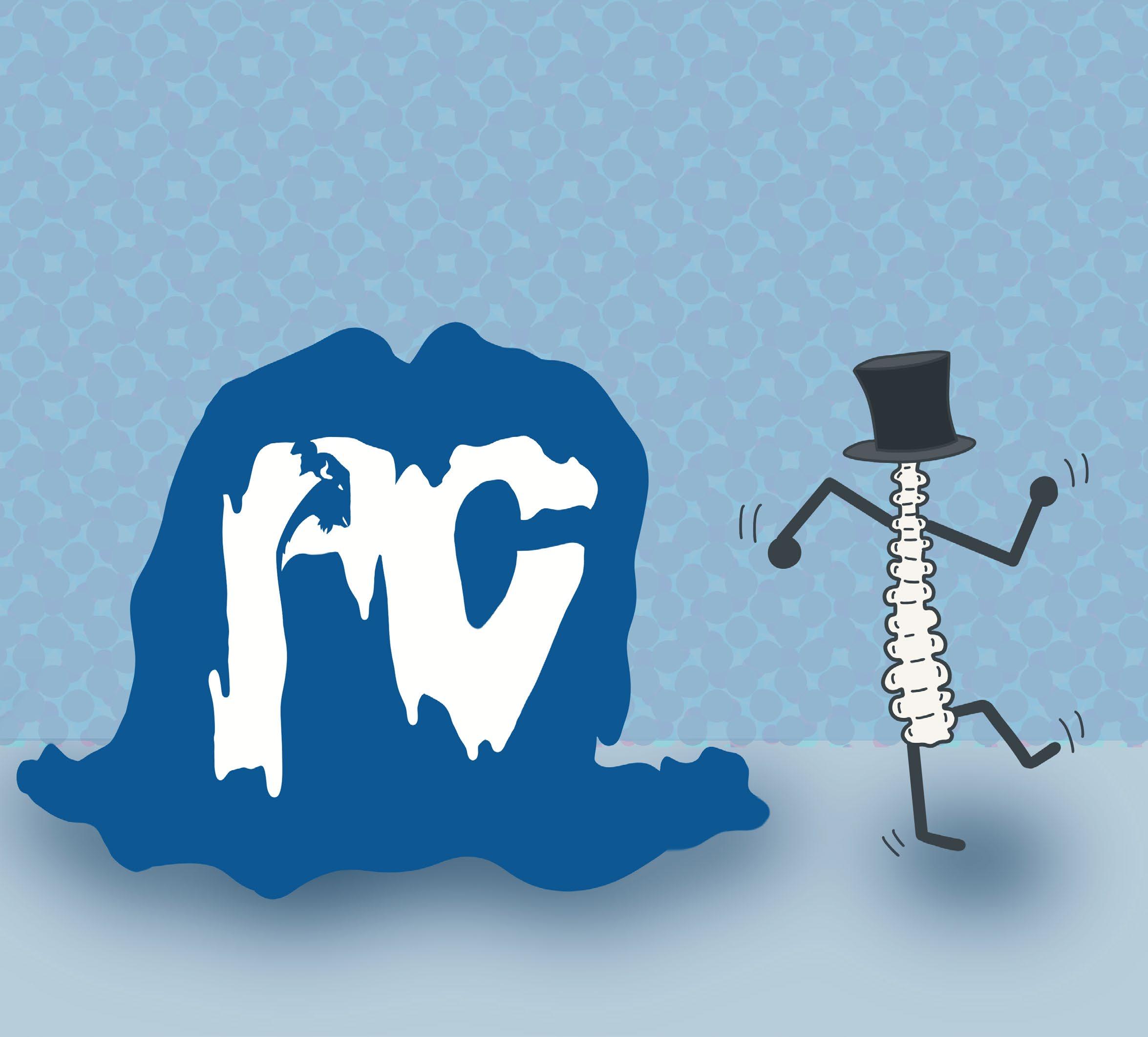
The way Klein pledged to tackle the issue is representative of the general structure of conservative politics
The University of Manitoba Students’ Union (UMSU) represents the undergraduate students at the University of Manitoba. We are here to advocate for the student body at all levels of government and enhance your student experience by offering a variety of programming, providing supports and resources, and hosting events aimed at enriching campus life.



Illegality of dumpster diving in Winnipeg facilitates waste
In a climate crisis, let the people pick through trash
Jessie Krahn, staffIn this economy, the discarded microwaves and half-eaten red velvet cakes in my apartment complex’s dumpster are their own sweet temptations. However, I am defiant in private and a pathetic rule-follower in public. I can’t bring myself to take anything.
Under Winnipeg bylaws, scavenging or picking through garbage bins that you don’t own is prohibited. Similarly, Winnipeg disallows rifling through garbage at designated waste disposal sites.
Obviously, this bylaw is not strictly enforced. Anyone who has set foot in Winnipeg has seen someone picking through a garbage bin. Even so, think about what it means for restrictions like these to exist in Winnipeg’s bylaws.
Presumably, if something is in a trash bin, the person who owns the bin doesn’t care about it anymore. Laws about picking through trash display a strain of militant selfishness in the culture of this city, where we have a possessive need to feel in control of even our garbage until it’s out of sight and mind.
But what is even more revealing about these bylaws protecting garbage is that they show we are fully aware we’re throwing things away that are usable. People pick through garbage because, amidst rotten food and unnervingly browned articles of clothing, there is something of value to them there. Rather than ban throwing away usable things, the city has prohibited people salvaging usable things.
Divers have long reported being hassled about the activity at times. For poor Winnipeggers, dumpster diving is an important supplement to other ways of collecting income, according to one Edmonton social survey.
In some Canadian municipalities, dumpster diving is becoming more and more necessary as grocery prices skyrocket. If Toronto can allow dumpster diving without falling apart, Winnipeg can too.
There are also communities of people around the world who dumpster dive not out of necessity, but for a range of other reasons. Some do it to save money, while others dive to try to divert waste from landfills that their municipal waste systems don’t bother to catch.
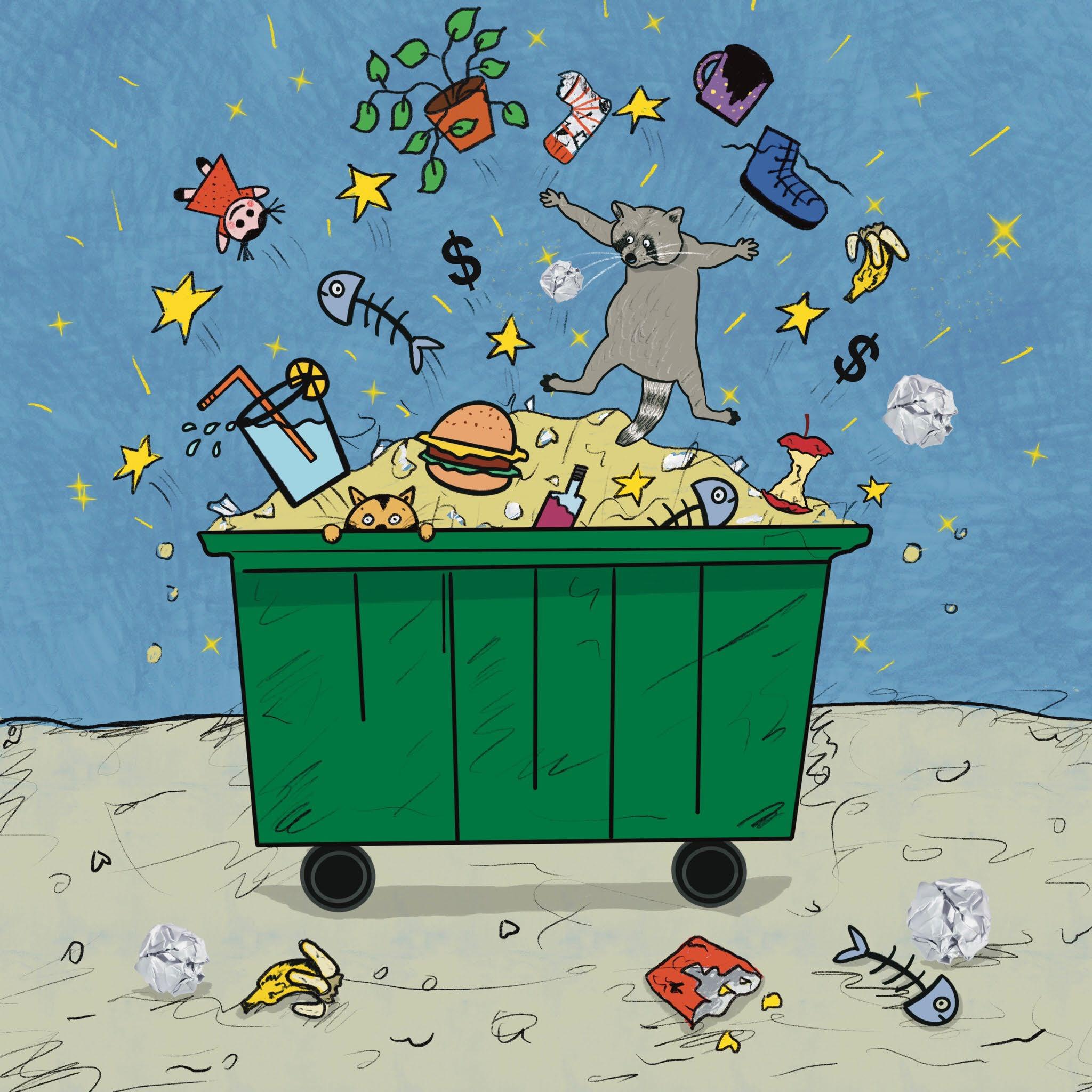
Instagram account @nyctrashtotreasures will salvage furniture, decorations and
other objects that are not yet at the end of their lives and refurbish them for resale.
Anna Sacks, also known as TheTrashWalker on TikTok, posts videos of the trash turned treasures that she rescues from New York’s curbside. Her videos show bags of edible food, working electronics, unused notebooks and tableware.
Businesses should not be chucking food out. Never mind food that’s close to expiry — and compostable at that. Most food should be donated before it’s wasted.
The knee-jerk response from insufferable twits who don’t Google the first thoughts their creativity starved minds can produce is that someone could get sick from businesses’ food donations. In that case, the donors would
be liable, then they would be mired in lawsuits and the stock market would explode.
But this is completely wrong. In Canada, food donors have extensive protections against civil liability in the event that someone eats spoiled donated food. The same is true in the United States.
Back in 2021, one grocery store in Oregon discarded literal tons of edible food during a power outage, and stationed police by the dumpster so people couldn’t scavenge any of it. In light of the fact that the food could have been donated at no risk to the business, the incident became representative of the vile, poisonous corporate laziness permeating the food industry’s approach to waste prevention.
The issue of corporate waste is distressing. In Canada, the amount of food wasted during the processing and
manufacturing of food could feed every Canadian for five months. Grocery stores alone are responsible for 1.31 billion tonnes of food waste annually in Canada.
Residential garbage tells a story too. Individuals are not informed about the proper ways to dispose of their waste. Electronics cannot be taken to the landfill, they need to be taken to an e-waste centre. I know from speaking to people in my community that many people are honestly ignorant of this, and those who aren’t do not have time or the means to cart their dead vacuum to Urban Mine.
Most of us assume that our waste system functions rationally, and that those in power would not seriously allow our embarrassing waste system to work the way it does. I believe things like used TVs end up in residential waste because people naively believe the government takes care of it.
For this reason, dumpster divers are heroes.
There are people who dive out of necessity, and it’s not okay that they have to do that.
I’m not celebrating the desperation of people who have no option but to dumpster dive. Whether they do it out of need or because they just find it fun, people who dumpster dive are diverting waste from the landfill because there are fundamental flaws with the way stuff is produced and discarded in this world, and dumpster divers — both the hobbyists and the necessities — are filling in until a better system is developed.
It shouldn’t be up to us to sift through garbage, the garbage shouldn’t be there in the first place. But if the City of Winnipeg won’t do the bare minimum and update its waste infrastructure, then the very least that it should do is free the dumpsters.
comment@themanitoban.com
Dumpster diving is becoming more and more necessary as grocery prices skyrocket





Transphobia is being allowed to thrive in the Prairies
And it’s been simmering for a while in Canada
Jacob Davis, staffDays after the 1 Million March 4 Children (1MM4C), I started seeing online articles that celebrated counter-protesters outnumbering the fringe, cross-country anti-trans protest.
While there were several provinces in Canada that did have such instances, this was not the case in Manitoba and the prairies as a whole.
In Alberta, Saskatchewan and Manitoba, there were more 1MM4C protestors than counter-protestors.
This thoughtless naivete and the urge to pretend that everything is alright leads to people ignoring the plight of trans communities in the Prairies, not only in regards to what occurred on Sept. 20, but what’s been happening in these places’ legislation as of late.
It’s an irresponsible perspective, especially considering the steady rise of transphobia in the Prairies, which is already bleeding out into other Canadian provinces.
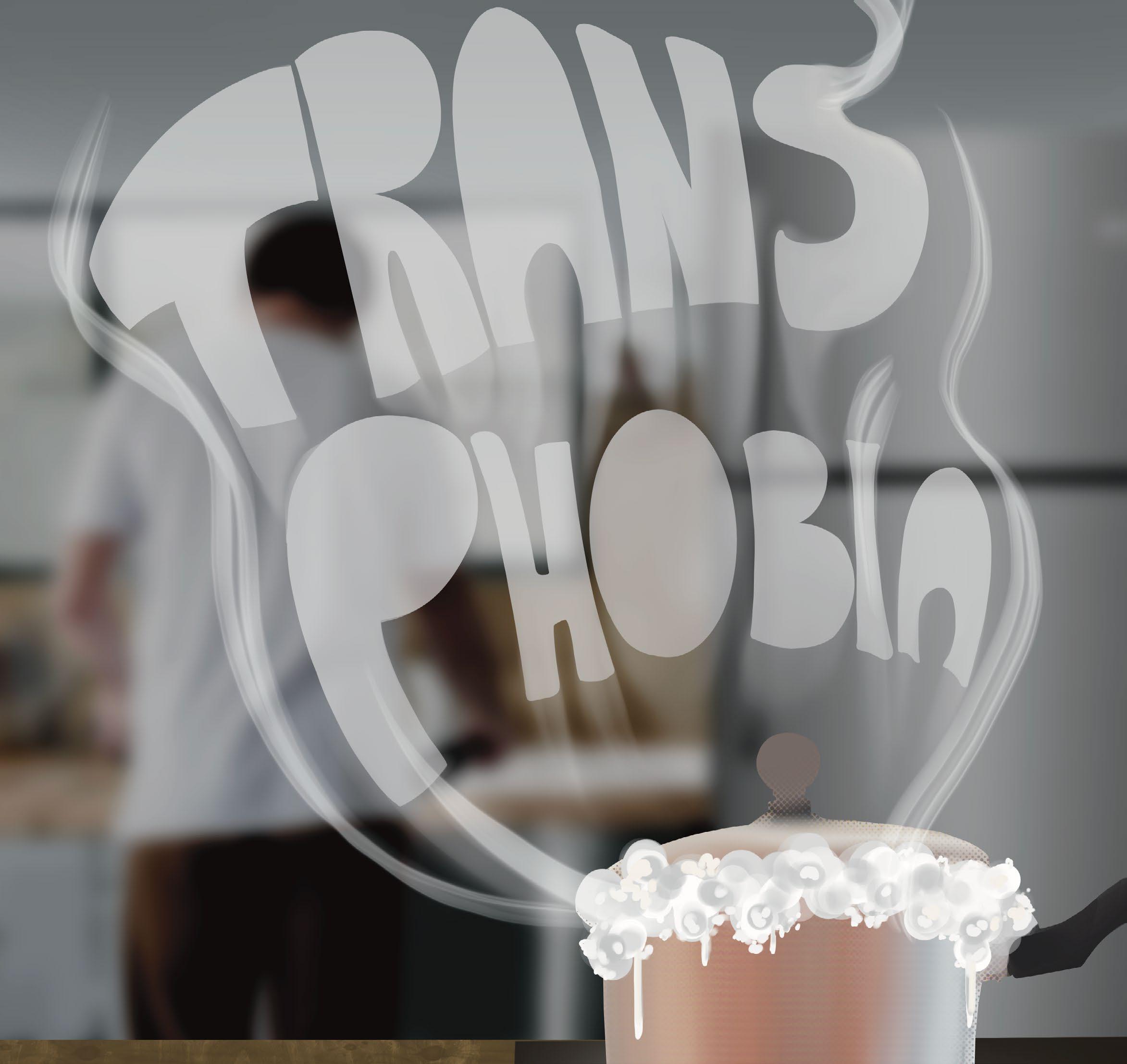
In Saskatchewan, then-education minister Dustin Duncan announced a new policy back in August that would require students under the age of 16 to seek parental permission to change their preferred name and pronouns in school, under the guise of wanting parents to have more involvement. The policy mirrored legislation in New Brunswick enacted under Education Minister Bill Hogan.
Six months ago in Winnipeg, there was a rally at the University of Winnipeg in opposition to a lecture by political science professor Joanne Boucher, titled “The Commodification of the Human Body: The Case of Transgender Identities.” The lecture was critical of gender-affirming care and included Boucher questioning the complications and long-term effects of surgeries. Despite a petition from concerned students, the U of W refused to intervene under the defence of academic freedom.
Over the summer, we saw a rise in southern Manitoba school divisions battles with book-banning. People claimed books with sexual education and health information in them, as well as books about 2SLGBTQIA+ lives, were “pornographic material.”
Simultaneously, over the past year, Winnipeg has been dealing with instances of protestors at Drag Queen Storytime events, in which drag queens and performers read books to kids.
Things are getting bad in
the Prairies. They have been for a while. And for months now I have been dealing with feelings of impending doom, wondering when this thing that I, and others in the community, knew was coming would arrive. It arrived on Wednesday, Sept. 20, and I vastly underestimated what I was going to encounter.
What started off as counter-protestors outnumbering 1MM4C protestors quickly reversed. Before I knew it, a large crowd of what felt like thousands in comparison marched toward the steps of the legislature building where we were stationed.
Apparently organizers underestimated the number of counter-protestors that would be arriving. Community members and allies collaborated as best they could to try to act in unison. Information was passed via word of mouth alongside recommendations for crowd safety. Myself and others made a decision to linger at the frontlines, where rightfully angry trans youth and allies were positioned, to de-escalate any situations that had the potential to go
sideways.
My fear was that if things got too heated, our small group of determined, strong, courageous and brave counter-protestors — many of whom were the very youth we were trying to protect — would without a doubt be harmed physically and have little protection.
These fears were confirmed when I witnessed a 1MM4C protestor throw a small object at a counter-protester beside me. I and another counter-protestor chased after this individual and informed an on-site police officer, who sauntered very slowly over to assess the situation.
The only thing that came of this was that the 1MM4C protestors were eventually told to back up a bit from the elevated station that bled into “our side” of the line. The line, which was monitored by a wall of officers who had to keep us separate from one another, was also poorly made and maintained.
Protestors were within lunging range of counter-protestors. They made crude gestures at us, they were able to spit at us and could specifically point
at and target individuals and yell disgusting things at them.
People posted pleas for help online, calling for more bodies to come to the legislative building, and the moment Sunshine House arrived — a harm reduction and social inclusion-focused community drop-in and resource centre — I felt safer.
Drumming, singing, and pots and pans banging together drowned out chants from the other side. Someone from Sunshine House was weaving through us carefully with medicine for individuals to smudge, which many did.
When I felt at my worst, making eye contact with a young man spewing hateful rhetoric toward me from the other side of the cop wall, I inhaled the sweetgrass in the air and knew that I did not stand alone.
The following Sunday a counter rally for trans youth took place at the legislative grounds and was larger than the hate people encountered on Wednesday, with over 1,000 people in attendance.
more. Without a doubt, Sunday proved that no one would be standing by and allowing anti-trans rhetoric to spread without resistance in Manitoba. It was a healing experience and I was so proud of the community action I saw.
However, even now, I cannot entirely shake the feelings I felt at that first counter-protest.
It’s a terrifying time to be trans, non-binary and gender non-conforming right now. The response that came from the community on Sunday cannot end there. What has been happening in the Prairies has or will happen in other regions of Canada.
The fight is not over and we need to remember that. We cannot allow clear transphobic rhetoric to have a voice or a platform. All it does is start the same pattern over and ends with trans people fighting for their lives again.
It seemed like everyone I had ever met was there and comment@themanitoban.com
To complete Sudoku, fill the board by entering numbers 1 to 9 such that each row, column, and 3x3 box contains every number uniquely. In Straights, like Sudoku, no single number 1 to 9 can repeat in any row or column. But rows and columns are divided by black squares into compartments. Each compartment must form a “straight.” A straight is a set of numbers with no gaps but it can be in any order, eg [7,6,9,8]. Clues in black cells remove that number as an option in that row and column, and are not part of any straight. Glance at the solution to see how “straights” are formed.
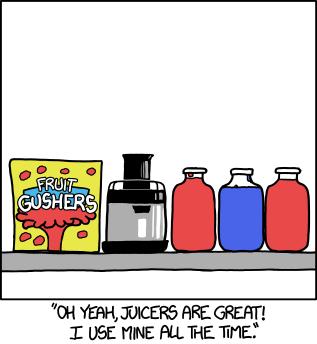






Mailiw: Conversations of home at the dinner table Installation
discussed home, community, language and diaspora at Nuit Blanche
Jacob Davis, staff
Local artists and their works filled Winnipeg’s Exchange District and downtown area on the evening of Sept. 23 for Nuit Blanche Winnipeg, an annual nighttime event that celebrates and explores contemporary art. Among the many installations was Mailiw, a love letter to the Philippines and to the desire to return home created by local queer and non-binary Filipinx artist Ally Gonzalo.
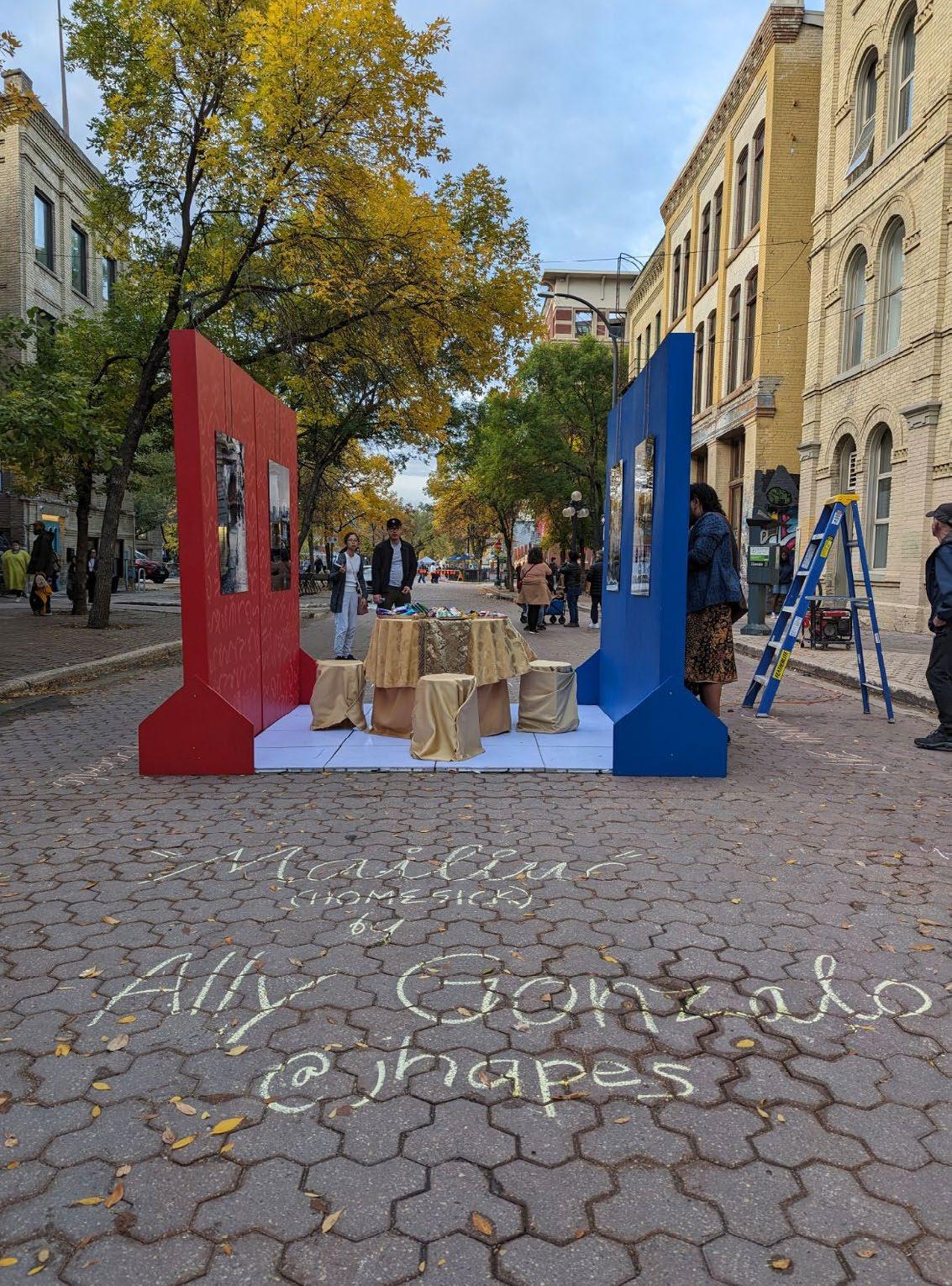
Gonzalo’s journey to Nuit Blanche Winnipeg began when they received an email from Culture Days Manitoba, a nonprofit that produces the event alongside the Winnipeg Arts Council. The organization invited Gonzalo and other local artists to submit pitches for art installations, and wanted to see what artists who had never made installations would come up with.
Mailiw, which means “homesick” in Pangasinan, was a three-dimensional installation that Gonzalo designed to represent the flag of the Philippines through its
use and distribution of colour — red and blue on the walls, white on the floor and gold on a table and three chairs.
The country’s national anthem was written on the walls of the exhibit in Baybayin, a pre-colonial script from the Philippines. Gonzalo said this was their way to reclaim the script and show others that it can still be learned and used today.
Photographs from Gonzalo’s archives were also displayed on the walls of the exhibit. Gonzalo chose eight photos, all taken about three
food was placed on the table for people to take.
“The installation is to invite people to come in,” Gonzalo said, adding that the exhibit was meant to convey “the atmosphere of what a Filipino home looks like.”
Home and feelings of homesickness were the main inspiration for Mailiw according to Gonzalo, who last went back to the Philippines four years ago.

The current political climate back in the Philippines and circumstances around the world make Gonzalo “a little bit scared” to return home.
years before they immigrated to Canada, to symbolize the eight revolutionary provinces in the Philippines that rose against the Spanish.
The interior of the installation represented Filipino hospitality and the experience of being welcomed into a Filipino home. A table was set up with Filipino music playing underneath it, and actual
“Us immigrants have a lot of reasons to want to go home and a lot of reasons that we’re not able to go home,” they said.
They explained that the exhibit is “a dedication, a tribute to all my fellow immigrants. Not just the Filipinx community, not just people from my community, but anyone whose idea of home […] is amorphous.”
While Nuit Blanche is now said and done, Mailiw’s legacy is not finished. The photographs used for the installation will be up for auction, and the funds raised will go to Art City, a non-profit community art studio that provides free programming for all ages, and to Sunshine House, a harm reduction and social inclusion-focused community drop-in and resource centre.
Gonzalo said they chose these organizations because of the work both do with youth. They said arts and creativity were missing from their adolescence, as they were expected to pursue careers in different fields.
“I’m an outlier in my family, pretty much the black sheep,
but I’m lucky that they’re supporting me,” Gonzalo said.
The auction will be online through Gonzalo, and further details will be provided through their Instagram page.
Instead of using real names for the auction, Gonzalo will use Instagram usernames to add some “levity” to the process. They stressed that despite the hardships queer communities are facing currently, there is “always time for queer joy, […] there is time for resilience.”
“This is actually the time to show, ‘hey, fuck you, we’re still here, we’re still happy.’”
Gonzalo said they are currently focusing on rest, as making art “takes a lot out of you, no matter how much you like what you do,” but they do have aspirations for the future.
“If we’re shooting high, I
am wanting to have my works eventually displayed at the Winnipeg Art Gallery,” they said, adding that being one of the first Filipinx artists to have their work displayed at the gallery would be an amazing experience.
Creating Mailiw for Nuit Blanche Winnipeg made Gonzalo realize how much their art matters, not only to them, but to others as well.
“It’s made them feel things, and I felt like I’ve accomplished my goal,” they said.
More details regarding the Mailiw print auction can be found on Gonzalo’s Instagram page, @Jhapes.
arts@themanitoban.com

“It’s made them feel things, and I felt like I’ve accomplished my goal”
— Ally Gonzalo, Artist and creator of Mailiw
Mitski, The Land Is Inhospitable and So Are We
We are no longer betting on losing dogs
Jacob Davis staff4.5/5 Stars
The Land Is Inhospitable and So Are We portrays love, loneliness and self-care in a musical language that acknowledges and feels resigned to its fate. Whereas previous albums by Japanese-American singer-songwriter Mitski have had an equal balance of fast paced, guttural tracks and sadder, slower melodies, her seventh album maintains an aura of being in the final stage of grief: acceptance.
Even on the album’s sixth track, “When Memories Snow,” a louder song on the album vocally, Mitski sounds starkly different from how we’re used to hearing her.
The figure here is no longer the young woman who screamed pleas to her mother into her guitar. This change was first heard through the experimental synth and pop melodies in Mitski’s 2022 release Laurel Hell, her first album following a multi-year hiatus.
Despite sounding very dif-
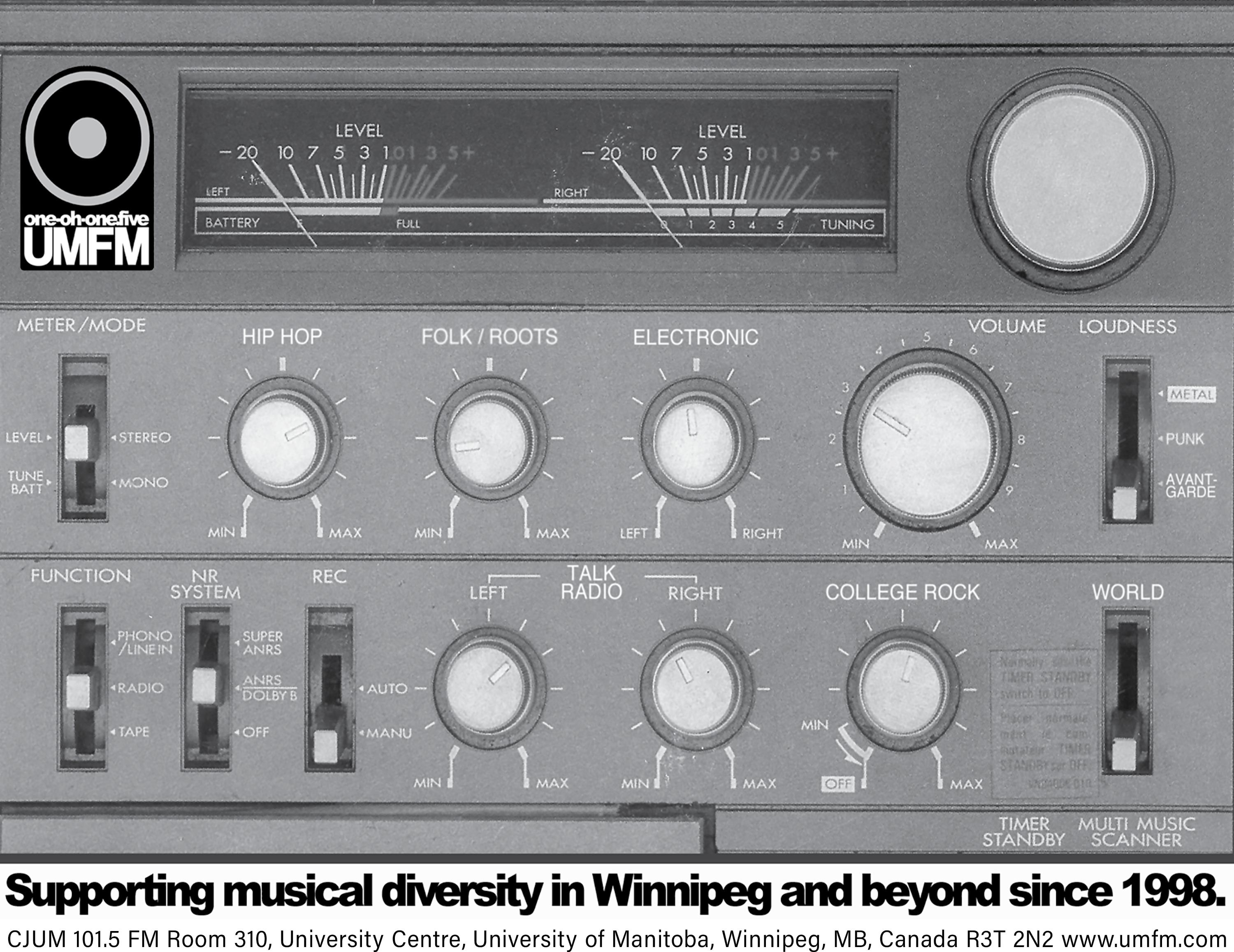
ferent from The Land Is Inhospitable and So Are We, Laurel Hell marked the beginning of a new era for Mitski, and that transformation has bled into her newest album.
Mitski continues to pursue more experimental sounds in her latest work, making use of a choir on some tracks and crafting a musical landscape so complex that, upon first listen, one may miss its intricacies.
The images conjured throughout The Land Is Inhospitable and So Are We pay homage to rural America, working in the Midwest-gothic. Every song feels like I am driving down country roads in an imaginary truck, dusk trailing behind me. A lonely atmosphere emanates from each of the eleven tracks, taking listeners on a road trip across lands of love and heartbreak.
The album sounds like something a modern cowboy would put on while engaging in self-reflection, the cowboy figure being one Mitski has referenced before in her previous works.
Track 10 on the album, “I’m Your Man,” deals with a lover anticipating the oncoming destruction of a relationship after their true nature, something they feel is abominable, is revealed to their other half. A pack of barking dogs begins is heard near the song’s end, and grows louder as the judgment the lover is so afraid of finally arrives.
This track is haunting, but the one that follows it to close out the album, “I Love Me After You,” tells a story of someone reclaiming themselves from a prior relationship. The speaker in this song is moving on and taking back the throne of their body.

It’s in these two tracks, cleverly and intentionally put back to back, that Mitski’s metamorphosis finally comes to fruition. While being known for her devastation, invoking feelings of desperation and sorrow that are relatable on what can feel like a metaphysical level, here we see her tackle these familiar ideas with this changed perspective of acceptance.
Painful things will happen to you, but to love is never a waste.
The Land Is Inhospitable and So Are We refuses to wallow in self-pity for too long, instead inviting listeners to be earnest with themselves and understand that while being
open to love means being open to heartbreak, love will always be worth it, no matter the destruction that follows.
arts@themanitoban.com
The stitch blanket sound of CMHR’s Music Scene
Tinge, Alpha Toshineza captivate with alluring soundscapes at Nuit
Sky Downing volunteerIn the early hours of the evening on Sept. 23, the downtown area filled with the buzzing of people eager to explore the arts and culture hub forming at Nuit Blanche Winnipeg. For the first time in the history of the event, the Canadian Museum for Human Rights (CMHR) became a venue for the evening, playing host to Music scene at the CMHR.
“Music Scene at the CMHR” captured the attention of a multitude of personalities and individuals. Children ran and danced in the melting pot of colours projected on a wall while a group of show boaters performed handstands and a juggler wowed a small audience in the back.
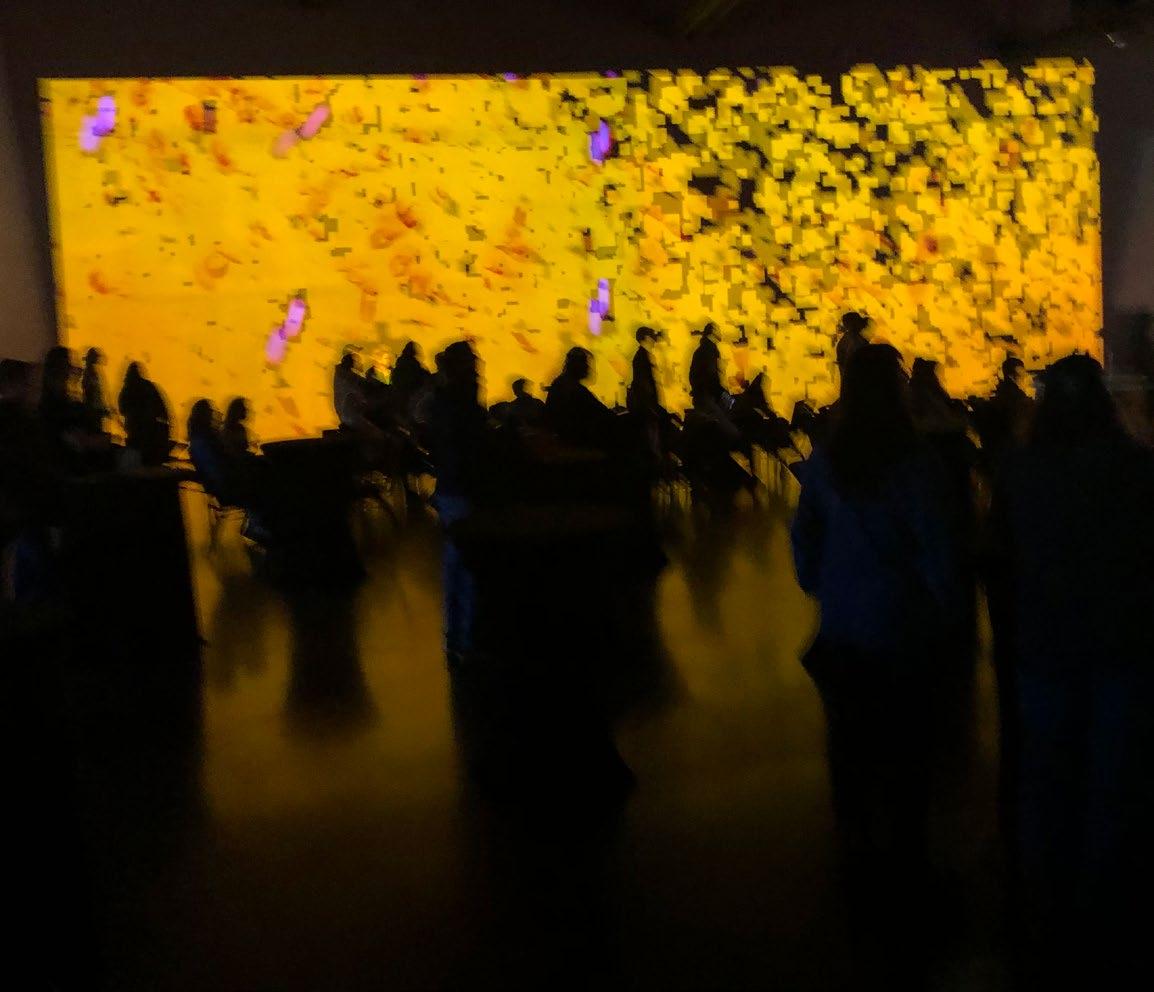
As the lyrical sensitivity of genres wrapped in the scuzzy grain of grunge rang from the speakers, a sense of welcome filled the space. Early attendees settled down to enjoy contemporary culture in a night of togetherness.
Dance music band French
Class kicked off the night before Tinge took the stage.
Sitting in the front row closest to the speakers, an audience member was headbanging to each beat, synchronizing with the music and feelings pouring through the CMHR. As attendees gathered their friends and orders, they settled in for a better view of the bandmates, taking in the
notes amid clusters of conversation.

Veronica Blackhawk, singer-songwriter for Tinge, wailed heart-touching, scratchy yet delicate notes alongside the hum of her amp, bringing a unique blend of somber melodies and brighteyed wisdom to the group’s performance.
Alongside Blackhawk,
Blanche
drummer Lincoln Brown and bassist Jordan Tait captured the vulnerability that comes with young love through head-rocking tempos and earworm basslines. These elements layered onto Blackhawk’s gentle words about the inability to make eye contact and the hope to get the one who caught your eye alone.
While Tinge captured a moment of lounging rock, an energizing performance from follow-up Alpha Toshineza breathed new political and personal light into the crowd.
Toshineza introduced his set with double-timed hi-hats, relentlessly steadfast beats and classic funk riffs.
Soundtracking as he shared his story of being raised in Europe and finding his way to Winnipeg, Toshineza professed his love-hate relationship for the city by turning grime into inspiration through his song “WPG TRNST.”
Rapping about breaking up with sadness and moving on while invigorating the crowd with call-back responses,
the French Canadian rapper ended the first half of his performance with “Chaque Jour.” Filling the space with a fast repetitive beat that urged the body to move, the performer was adamant that the crowd let go and enjoy themselves.
Nuit Blanche Winnipeg showcased a rich artistic community that saturates the city’s underground. The event brought people from different walks of life together to explore contemporary culture within Treaty 1 territory.
During this season of orange leaves and brisk days, “Music Scene at the CMHR” showcased an eclectic mix of young artists coming up within the seams of Winnipeg and provided a space for people to come together, have a drink and look into a new wave of music within the Winnipeg scene.
arts@themanitoban.com

For the herd — join the club
Become part of an on-campus recreational sports community
Grace Anne Paizen, staffAs the weather cools down to seasonal temperatures, there is a lot more to do than hibernate.
Students have access to wonderful on-campus programming that can keep them active — not only for a serotonin rush to beat the seasonal affective disorder blues, but to have an opportunity to join a campus community.
The university has lots to offer, whether students are looking for low-commitment recreational activities, an official recreational sports club or even a more competitive intramural league.
There are group fitness classes offered every day at the Fort Garry campus and on weekdays at the Bannatyne campus, encompassing everything from cycling to Zumba.
With the Joyce Fromson Pool having reopened on Sunday there are still swimming classes to sign up for, including the advanced Masters Swim Clubs.
For students wanting something more casual, drop-in casual rec use is a low-commitment option for not only the pool, but also the gyms on campus. Essentially, on-campus facilities have designated times where students can drop-in and use the spaces.
Drop-in casual rec opportunities include anything
from hitting the ice during free skate time at the Max Bell Centre’s Wayne Fleming Arena to rounding up a group of friends for a game of badminton or basketball. Students can find an exhaustive list of casual rec schedules on the university’s recreation services website.

These drop-in times have maximum capacity limits, so check online for those limits and plan accordingly. All drop-in casual rec use is free
for eligible University of Manitoba students, covered by the Sport and Rec fee included in tuition. Some equipment is provided on site but make sure to check what is available, as all other equipment will be the responsibility of the student.
Students wishing to take a more committed approach to the on-campus recreational sports community can join one of the UM Rec clubs. From the leisure climbing club to
the competitive ringette club, there many opportunities for students to join a dedicated recreational community.
Information about joining a UM Rec club can also be found on the recreation services website, along with details on how the clubs are organized and whether a club is for the leisurely or the competitive.
intramural sports leagues. From the usual suspects of basketball, hockey, soccer and volleyball, to innertube water polo and cricket teams, the intramural leagues are for more experienced students.
While there are competitive intramural leagues, there is also the recreational league if students wish to join a sports community and just have fun.
It should be noted that the majority of UM Rec clubs as well as the intramural sports teams are not covered in the Sport and Rec fee and require additional spending. All information about the prices of these clubs can be found online.
Remember, physical activity can help decrease anxiety and depression, and being part of a community contributes to overall well-being. So as the days grow shorter and colder, join a club, make some new friends and combat university stress with well-deserved fun.
Additional information about any of this programming can be found at umanitoba/community/sport-recreation/recreation-services.
The most serious recreational on-campus communities students can join are the sports@themanitoban.com
Sports teams’ schedules
U


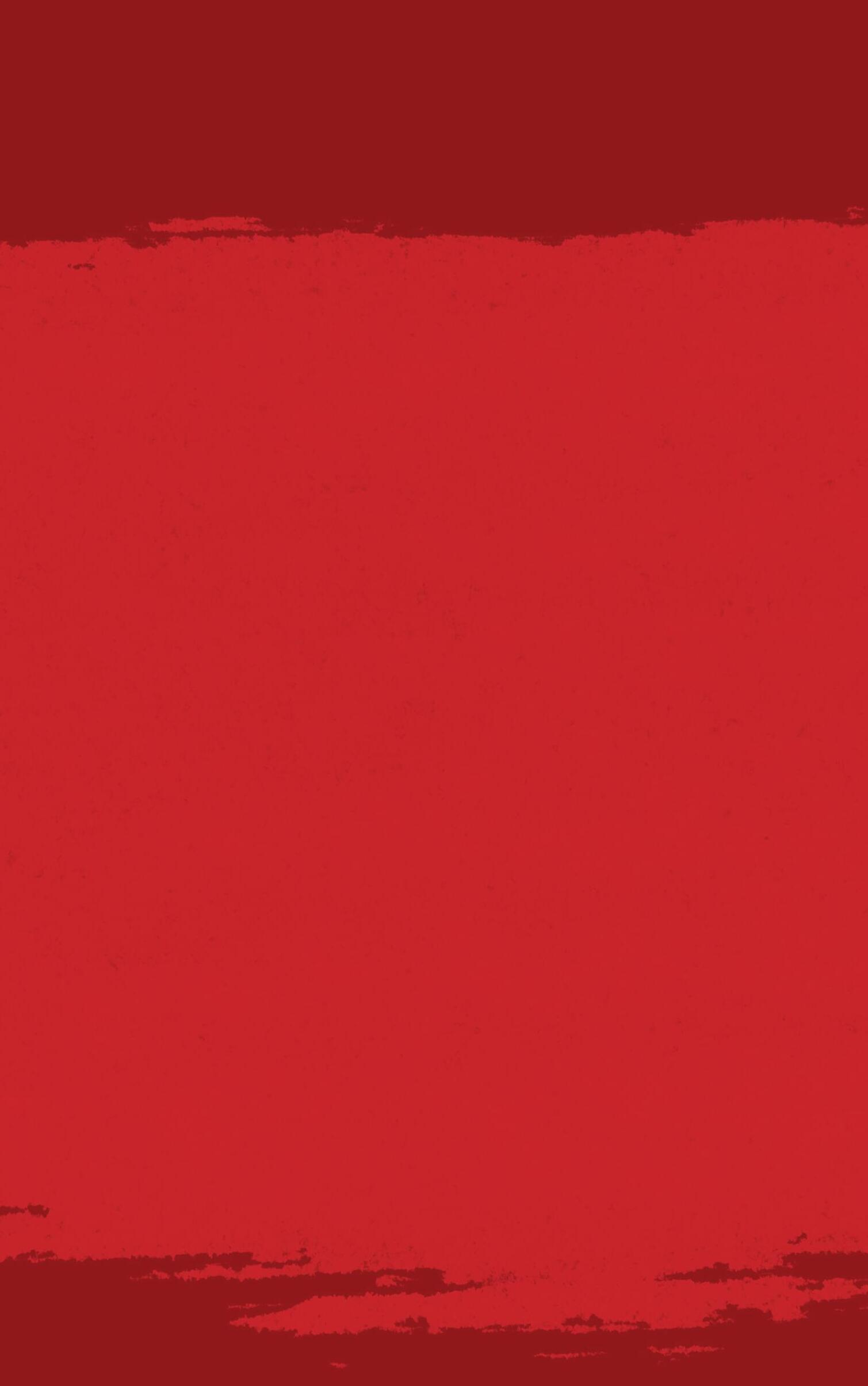








Bison briefs
Grace Anne Paizen, staffBisons cross-country
The Bisons cross-country team raced in the inaugural Dakota Classic this past Saturday. Formerly known as the Sled Dog Open, the race was co-hosted by the Whitecap Dakota First Nation and University of Saskatchewan Huskies as a way to put reconciliation into action. The event marked the first time a Canada West race has ever taken place in a First Nation community.
At this historic event, three of the Bisons runners on the women’s side finished in the top 20. Angela Kroeker placed 11th, rookie Lena Klassen placed 13th and veteran Hailee Morisseau placed 18th. For the second race in a row, Angela Kroeker finished first overall on the women’s side of the team.
On the men’s side of the team, four finished in the top 15. Justin Kroeker placed third with the fastest overall Bison time of 27:14.1, while veteran Calvin Reimer placed 10th, Noah Fillion placed 11th and rookie Carson Kroeker placed 12th.
The Bisons next race will take them to Calgary for the Stewart Cup, hosted by the University of Calgary Dinos on Oct. 14.
Bisons football
The Bisons football team picked up its second win of the season Sunday, hosting the University of Calgary Dinos at IG Field.
The herd started the game with a two and out, which was followed by a Dinos touchdown. However, the Bisons punched right back in their second possession. Marching downfield, the Bisons’ first touchdown of the day came courtesy of quarterback Jackson Tachinski, and the Bisons wouldn’t look back from there.
Manitoba put up two more touchdowns in the first half, taking a 21-7 lead into halftime. The herd would put up another 13 unanswered points, including two field goals from kicker Maya Turner in the second half. The Dinos would put up two touchdowns late in the game, but the Bisons would come out of the dominating performance winning 34-21.
Turner put up 10 points for the herd and had impressive kickoffs throughout the game, her longest being a 60-yarder. Receiver Nathan Udoh assumed punting duties on Sunday, his longest a 47-yarder.
Running back Breydon Stubbs had a rushing touchdown on the day. Tachinski — who recorded over 100-yards rushing on the day, a first for the quarterback with the herd — had two rushing touchdowns. Tachinski also found receiver Brendt Adams in the endzone for the lone Bisons’ receiving touchdown of the afternoon.
On special teams, receiver Michael O’Shea Jr. led the herd with six punt returns on the day. O’Shea Jr. also had his second fabulous touchdown return off a missed opposing
team field goal attempt of the season negated by a flag.
The defence recorded five break ups, with linebacker Nick Thomas recording the lone forced fumble for the Bisons and fellow linebacker Markos Bockru recording the lone interception of the game.
This next weekend is a bye week for the herd, with the Bisons returning to the gridiron on the road Oct. 14, hosted by the University of Regina Rams.
Bisons golf
The Bisons golf team was back in Minnesota, hitting the links in the Twin Cities Classic from Sept. 23 to 25. Hosted by the Gustavus Adolphus College Gusties, the herd took on the par 72 Elk River Country Club course, the par 72 The Links at Northfork course and the par 70 Le Sueur Country Club course over the tournament’s three days.
The best overall scores came courtesy of veteran Lachlan Allerton and rookie Chase Janas — who both played the tournament as individuals — shooting +17 and +20, respectively. Allerton also had the best outing on his second day, shooting an impressive -1 on The Links at Northfork.
Jordon McDonald and rookie Jack Rudick both shot +24, with their best outings on the par 72s. Veteran Cole Peters shot +26, recording his best outings on the last two days of the tournament. Rookie Jose Mekish-Lacquette shot +27 and veteran Trent Robertson
shot +30, both recording their best scores on their second day.
The Bisons clocked in 23 birdies over the tournament and faired best on par 5s.
At time of publication, the herd will be wrapping up the 2023 Canada West Championships tournament hosted by the University of the Fraser Valley Cascades in Abbotsford, B.C.
Bisons hockey
The puck dropped on both the women’s and men’s hockey teams this past weekend when the herd faced the University of Saskatchewan Huskies both at home and on the road.

The men’s team hosted Saskatchewan on Thursday and Friday at Wayne Fleming Arena, unfortunately dropping both games to the Huskies. In the opener, the Bisons were walloped in the first two periods before playing a much better third, but only managed to net one goal courtesy of defencemen Chase Hartje in the 6-1 loss.
Goaltender Simon Harkness was pulled late in the second frame, giving fellow goalie Kolby Thornton time to shine. Thornton would go on to start the final game of the series and ended up standing on his head, facing 42 shots by the end of the 60 minutes.
The Bisons had a much better start in game two, entering the first intermission 1-0 with a goal from veteran forward Tony Apetagon. However, the Huskies came out and put
three goals on the board in the second. Despite a power play goal from Bisons captain Jonny Hooker late in the second and a great third period effort, the herd lost 3-2.
In Saskatoon, the women’s Friday night game started quite evenly with the Huskies opened the scoring, but the Bisons punched back with a goal from veteran forward Kate Gregoire. While the teams went into first intermission tied at one, the Huskies came out blazing, scoring three goals in the second frame. The Bisons managed a second goal in the third courtesy of veteran forward Sarah Dennehy, but Saskatchewan would go on to win the game 4-2.
While goaltender Emily Shippam got the start in game one, head coach Jon Rempel started Meagan Relf in net for game two. Again, the first period was fairly even, the two teams going into intermission tied 0-0 and the Bisons outshooting the Huskies 10 to nine. However, by the end of the second frame, the Huskies had again scored three goals, adding a fourth goal in the third and shutting out the Bisons 4-0.
Both teams are on bye weeks this weekend, with the women’s home opener scheduled for Oct. 13 against the University of British Columbia Thunderbirds, while the men’s team will travel to Vancouver to also face the T-birds next Friday.
sports@themanitoban.com
